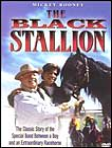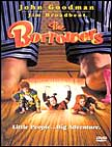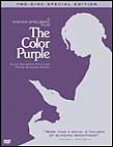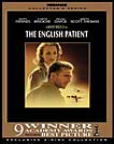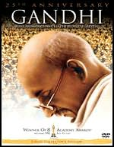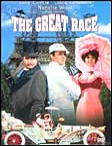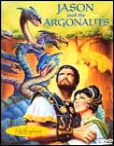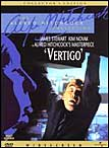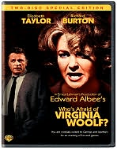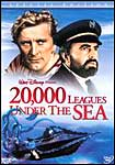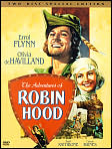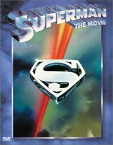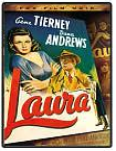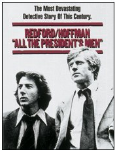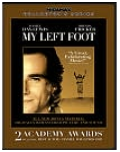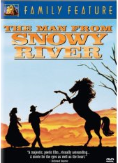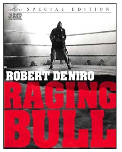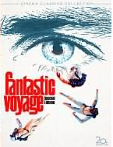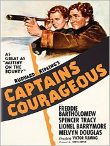

| brucekluger.com |
Barnes&Noble.com
By Bruce Kluger 20,000 Leagues Under the Sea (1954) Director: Richard Fleischer; cast: Kirk Douglas, James Mason, Paul Lukas, Peter Lorre
than Jules Verne; for lovers of movie magic, Walt Disney is the man to beat. It's no surprise, then, that when Verne and Disney come together on the big screen, all bets are off. Film history was made in 1954 with the arrival of director Richard Fleischer's 20,000 Leagues Under the Sea, the long-awaited Disney adaptation of Verne's underwater classic. Verne's story concerns an 18th-century mariner (Kirk Douglas) who is kidnapped on the high seas by Captain Nemo (James Mason), the mad pilot of a futuristic sub. A half century ago, this
industry for its grand scale and even grander production costs. But in the end, the efforts (and the salaries) paid off. The movie's still-breathtaking special effects— which include, among other pitched battles, the famed hand-to-tentacle combat with a mammoth squid—earned an Academy Award. Perfectionists take note: 20,000 Leagues took full advantage of all Cinemascope had to offer, and subsequent TV showings and video releases have chopped up the film's panoramic vistas. So go for the letterboxed editions where available, and find yourself a great big TV. —Bruce Kluger
Director: Michael Curtiz, William Keighley; cast: Errol Flynn, Olivia de Havilland, Basil Rathbone, Claude Rains
the Kevin Costner vehicle Robin Hood: Prince of Thieves, Sherwood Forest has been fertile ground for moviemaking. No version, though, says "Welcome to Sherwood," with anywhere near the pizzazz of this 1938 classic, in which Errol Flynn memorably utters that very line from atop a tree limb, smiling with the debonair grace that defined his legend. The story's framework is adventure 101: Robin takes on the bad guys in the name of justice and, after a few setbacks, emerges thrillingly
familiar setup seems more blueprint than boilerplate thanks to Flynn's inimitable screen charisma. Swashbuckling through the action sequences (sword fighting, wielding bow and arrow, swinging onto rooftops), Flynn turns in what most critics agree is the finest performance of his film career. Amazingly, Flynn wasn't even nominated for an Academy Award, although the movie did pick up Oscars for art direction, editing and Erich Wolfgang Korngold's thrilling score. The supporting cast, meanwhile, isn't exactly an amateur troupe. Joining Flynn in his adventures are, among others, Olivia de Havilland as Marian, Claude Rains as Prince John, and Basil Rathbone as Sir Guy of Gisborne. Together they make joyous movie magic, the swashbuckling adventure against which all others must be measured. —Bruce Kluger
Director: Alan J. Pakula; cast: Dustin Hoffman, Robert Redford, Jack Warden, Martin Balsam
decades—or even centuries—to explore the real-life drama of, say, the Vietnam War. But in the case of All the President's Men, director Alan J. Pakula set a particularly high bar for himself, depicting a complex chapter of American political history only two years after the actual events had transpired. Based on the prize-winning book by Washington Post reporters Bob Woodward and Carl Bernstein, the story details the step-by-step investigation of the Watergate scandal that led to the 1974
and Dustin Hoffman did formidable legwork researching the intrepid journalists, and their efforts paid off—Redford conjuring to perfection Woodward's fastidious, almost irksome, penchant for exactitude; Hoffman painting Bernstein as a charming (if a bit reckless) go-getter with an eye for good copy and attractive women. And Jason Robards brings the right blend of grumpiness and grit to the role of Post editor Ben Bradlee. The story has a tragic inevitability—from an absurdly bungled break-in at an office building to the systematic crumbling of a presidential administration—which Pakula captures vividly in this edge-of-your-seat political thriller. —Bruce Kluger Black Stallion (1979) Director: Carroll Ballard; cast: Kelly Reno, Mickey Rooney, Teri Garr, Clarence Muse
astounded to discover that they have become thoroughly engrossed in a film that has, so far, featured almost no dialogue. Indeed, when director Carroll Ballard chose to adapt Walter Farley's boy-meets-horse children's tale for the big screen, he clearly decided to make the visuals speak for themselves. And as the story unfolds—from an ocean liner to a desert island to a racetrack—the potent beauty of the physical world, courtesy of cinematographer Caleb Deschanel, is the film's true headliner.
discovers a dauntingly beautiful Arabian stallion in the ship's cargo hold. Just as Alec is beginning to make contact with the animal, an unexpected storm sinks the ship, landing the boy and the horse on an uninhabited isle. So begins a relationship as uniquely touching as it is unpredictable and untamed. Halfway into the movie, a new story line takes root—the boy is rescued and takes the stallion back home with him, where he befriends a horse trainer (Mickey Rooney) who turns him into a budding jockey. But what sustains the film through to its final frame is Ballard's commitment to his themes: the jaw-dropping majesty of nature and the invincibility of a boy's love. —Bruce Kluger The Borrowers (1997) Director: Peter Hewitt; cast: John Goodman, Jim Broadbent, Mark Williams, Hugh Laurie
from the mid-Twentieth Century. Even Disney's grip on cinema began to slip by the late '60s, after the release of Mary Poppins in 1964. So when a film comes along that merits consideration among the great family adventures of all time, one would expect it to make a bigger splash than The Borrowers did upon its release in 1997. But certainly success at the fickle box-office is not aprerequisite for greatness; and in it's own charming way, this deft blend of modern-movie wizardry and old-fashioned
classic collection of tales about a family of four-inch folk who live beneath the floorboards of a British cottage, where they occasionally loot the belongings of the house's tenants, the Lenders. When an odious realtor (John Goodman) tries to evict the family and demolish the home, the Borrowers and Lenders join forces, ultimately leading to a face-off that is as satisfying to witness as it is skillfully executed. Although much of the action favors the conk-on-the-head style comedy popular in the '90s (as in the Home Alone series), the clever visuals—including large-scale sets and overblown props—keep the proceedings lively, as does Goodman's turn as the greedy land-grabber. He's perfectly despicable, and thoroughly delightful. —Bruce Kluger Captains Courageous (1937) Director: Victor Fleming; cast: Spencer Tracy, Freddie Bartholomew, Lionel Barrymore, Melvyn Douglas
series of leading roles for which he became forever associated, from Hemingway's The Old Man and the Sea to Katharine Hepburn's foil in some of Hollywood's best romantic comedies, such as Adam's Rib. But in 1937, Tracy —then among the decathletes of character actors—took on the role of Manuel, the Portuguese fisherman in the screen adaptation of Rudyard Kipling's adventure tale, Captains Courageous. Equal parts action movie and allegory, the story concerns Harvey Cheyne
ocean liner, is hauled from the sea by Manuel (Tracy), a doryman on a Gloucester fishing ship. Instead of returning the boy to shore, Manuel and his shipmates put Harvey to work, informing him that there's no going to shore until the ship's hold is full of fish. While the rest of the film provides enough action and scenery to hold the attention of viewers both young and old, its best attraction is in watching Tracy dole out the kind of wisdom, guidance, and love that Harvey, and any child, so clearly requires. Tracy won an Oscar for his performance, which is supported by, among others: Melvyn Douglas as Harvey's well-meaning tycoon dad; Lionel Barrymore, as the fishing vessel's wise, crusty captain; and Mickey Rooney as a young mate on the ship. It remains among the great all time screen yarns. —Bruce Kluger The Color Purple (1985) Director: Steven Spielberg; cast: Danny Glover, Whoopi Goldberg, Margaret Avery, Oprah Winfrey
whose glittering screen career had relied so far on man-eating sharks, flying saucers and extraterrestrials. Yet, in the end, Steven Spielberg's adaptation of Alice Walker's Pulitzer Prize- winning novel transcended his other works, in part because it was so different. Whoopi Goldberg gives a heart-breaking, Oscar-nominated performance as Celie, a Southern black woman who in the early years of the 20th century finds herself a slave within her own home—married to a violently abusive
she'd been forcibly separated when they were young girls. The script dips and soars through a series of poignant, sometimes melodramatic vignettes involving racist mobs, illicit love affairs and religious salvation, the latter scenes backed by a clapping and stomping gospel choir. Through it all Spielberg effectively captures the small but crucial victories of the human spirit which punctuate the story and make for an original and uplifting film. —Bruce Kluger
Director: Anthony Minghella; cast: Ralph Fiennes, Juliette Binoche, Willem Dafoe, Kristin Scott Thomas
Anthony Minghella, The English Patient unspools the story of Laszlo Almasy (Ralph Fiennes), a Hungarian mapmaker recovering, in an abandoned monastery in Italy, from a near- fatal plane crash. Because he is barely able to speak, his nurse and caretaker, Hana (Juliette Binoche), reassembles his life story from his random writings and what remains of his rapidly deteriorating memory. This unusual narrative assured that The English Patient would be a most unconventional World War II
evokes the trackless dunes of the Sahara Desert and the elegantly rustic retreats of North Africa, escaping into the locales of Almasy's memories. And in a brilliant achievement of cinematic art, Minghella manages to distill the book's passion and pour it forth in a fluid narrative. Almasy's mysterious past and, most compellingly, his passionate love affair with a married Englishwoman (Kristin Scott Thomas), drive the film's action—while the hopeful subplot of Hana's love affair with a handsome Sikh anchors the film in the nurse's reality. Breathtakingly romantic, The English Patient earned nine Academy Awards, including Best Picture, Best Cinematography, and Best Score. —Bruce Kluger
Director: Richard Fleischer; cast: Stephen Boyd, Raquel Welch, Edmond O'Brien, Donald Pleasence
triumphantly transport us beyond the province of our own physical universe, a unique film had its engines in reverse, charting an excursion not into the great beyond, but within the mysterious confines of the human body. So inventive are the premise and execution of Fantastic Voyage that fans continue to regard it as a milestone of cinematic sci-fi, both in terms of its commercial success and its universal appeal. Part adventure tale and part thriller, the story concerns a group of scientists
and injected into the bloodstream of a dying scientist in order to save his life. Among Boyd's intrepid scientific team are sci-fi favorite Donald Pleasance (Escape From New York) and Raquel Welch, at the time moviedom's newest bombshell. An Oscar-winner for Cinematography, Art Direction, Sound Effects, Visual Effects, and Editing, perhaps the film's greatest achievement is in the way its story remains riveting despite all the eye-popping visuals. If high school anatomy classes were anywhere near this fascinating, we'd be a nation of doctors. —Bruce Kluger Gandhi (1982) Director: Richard Attenborough; cast: Ben Kingsley, Candice Bergen, Edward Fox, Sir John Gielgud
explores the inspiring, complicated life of Mohandas K. Gandhi, the Indian lawyer who through ideological conviction and an impassioned sense of political justice went on to become the spiritual leader of a nation and the symbol of its hard-won independence. Ben Kingsley won an Oscar in the title role, and he is supported by an all-star cast that includes Candice Bergen as photographer Margaret Bourke-White and John Gielgud as Lord Irwin. This is a big story to tell, and Attenborough tackles
propelled him along his historic journey: his awakening to the injustice of Britain's resistance to Indian independence; his renunciation of his personal effects; his development of a "passive resistance" strategy in retaliation against the British army (which later inspired Dr. Martin Luther King); and, most memorably, his dramatic fasting in the name of his cause. As Gandhi, Kingsley, turns in an unforgettable performance, cloaking himself in the indomitable spirit of the soft- spoken yet determined pacifist, as he seamlessly evolves from citizen to statesman to modern-day messiah. —Bruce Kluger
Director: Blake Edwards; cast: Jack Lemmon, Tony Curtis, Natalie Wood, Peter Falk
Blake Edwards perfected the craft of extracting the ridiculous from the sublime, while managing to throw in a healthy dose of slapstick in the process. The Great Race was no exception to this winning formula, as Edwards assembled an all-star cast and a fast-paced script to create a textbook model of the big-screen comedy adventure. As a story, the movie skewers a real bit of history—the turn-of-the-century automobile contests that were as emblematic of the times as bowler hats and bustles. In the
diamonds) faces off against nefarious Jack Lemmon in a 22,000-mile auto race from New York to Paris (you read that right). Add to the mix a third driver, Natalie Wood as a suffragette out to prove that women can press the pedal to the metal like any man, and you've got a two-and-a-half-hour joyride that can stand among the big-screen spectaculars of the era. (The film arrived in theaters in 1965, only two years after It's a Mad, Mad, Mad, Mad World and the same year as Those Magnificent Men and Their Flying Machines.) In fact, just as you're thinking that Edwards has loaded up the film with everything but a free-for-all pie fight—alas, one breaks out! And like everything else in this old-fashioned romp of a movie, it's joyfully over the top. —Bruce Kluger Jason and the Argonauts (1963) Director: Don Chaffey; cast: Todd Armstrong, Nancy Kovack, Gary Raymond, Laurence Naismith
beginning—from the 1918 Hungarian silent Aphrodite to Woody Allen's fractured fable Mighty Aphrodite in 1995. But what makes the 1963 screen adaptation of Jason and the Argonauts stand out from the pack is the special-effects mastery of Ray Harryhausen who, in a time before Industrial Light & Magic and Pixar, stood alone as the one-man-band of movie magic. Having already treated film fans to a smorgasbord of dazzling eye candy—from the murky inhabitants of It Came from Beneath the
Harryhausen pulled out all the stops for this popular Greek myth. Jason (Todd Armstrong), in an honorable quest for the Golden Fleece, receives aid from the goddess Hera (portrayed by Honor Blackman, one year before her turn as Pussy Galore in the Bond thriller Goldfinger). Despite Jason's derring-do, it is Hera's divine intervention that spares him in a series of encounters with Harryhausen- inspired nemeses, including: a multi-noggined hydra, a statue-come-to-life and, in the film's most memorable segment, a septet of sword-fighting skeletons. Parents will admire the rich cinematic history of Jason and the Argonauts; kids will just find it a blast to watch. —Bruce Kluger
Director: Otto Preminger; cast: Gene Tierney, Dana Andrews, Clifton Webb, Vincent Price
Vera Caspary's novel (and his first major feature) adheres to film noir conventions. It is a dark, melodramatic thriller, awash in cool shadows and snappy dialogue. Yet the film also possesses an air of refined urbanity and offbeat elegance, qualities not usually found among the moody mysteries and tortured love stories of the noir genre. Plotwise, Laura hits the ground running. In the opening sequences, we quicklylearn that titular beauty Laura Hunt (Gene Tierney) has been found on the floor
(Dana Andrews) to find the killer. Aided only by a breathtaking portrait of the deceased, McPherson systematically grills the small coterie of eccentrics who knew her best and, in the process, finds he is falling in love with her. The compelling whodunit story line—including a surprise appearance by Laura herself—keeps viewers riveted, but it is Preminger's casting of the film that makes it unforgettable. Before Laura, neither of the leads was a Hollywood superstar; yet under Preminger's baton, Andrews transforms McPherson into a man possessed, while Tierney turns in the most glamorous role of her film career. (Both actors would work with Preminger again, notably in the 1950 noir jewel, Where the Sidewalk Ends.) Broadway veteran Clifton Webb also drew raves with his winning turn as sassy columnist Waldo Lydecker, and composer David Raksin contributed the stirring title theme—itself a classic study in enigmatic beauty. —Bruce Kluger The Man from Snowy River (1982) Director: George Miller; cast: Kirk Douglas, Kirk Douglas, Jack Thompson, Tom Burlinson
into an old-style western, setting it Down Under, and convincing a legendary American actor to take the lead role—make that two lead roles—would seem dubious, at best. Yet somehow 1982's The Man From Snowy River, starring Kirk Douglas, managed to transcend its unconventional ingredients to become one of the more beloved family films of its time. The story concerns a willful Aussie mountain man (Tom Burlinson) who takes a job working for a cattle baron and falls in love with the boss's daughter (Sigrid Thornton). Along the way, he becomes entangled in a
Douglas plays both the powerful cattleman and his estranged twin brother—a crusty prospector named Spur—with the resonating perfection that has become the hallmark of his career. Chock full of pulse-quickening action scenes and eye- popping scenery, especially the rich mountain vistas of the Australian frontier, the movie found its largest audience on video, and even went on to inspire a sequel (Return to Snowy River, 1988). Alas, like most movie follow-ups, the sequel only makes us long for the original. —Bruce Kluger
Director: Jim Sheridan; cast: Daniel Day-Lewis, Ray McAnally, Brenda Fricker, Ruth McCabe
consistently— and seemingly effortlessly—tapped into the machismo and swagger of the many characters he's chosen to portray -- from the rugged settler of Last of the Mohicans to a former IRA soldier in The Boxer to the irrepressible rake of The Unbearable Lightness of Being. All of which makes his Oscar- winning performance in My Left Foot so worthy of recognition. Playing the real-life Christy Brown—the renowned Irish author and painter who suffered from cerebral palsy—Day-Lewis was
which were particularly pretty to look at. Grunting his words through a contorted mask of tics and winces, Day-Lewis learned to use, as Brown did, the only unafflicted part of his body—a foot—for his daily functions. Still, to many critics, the actor's greatest achievement was his ability to make the audience care about Brown without compromising the character's more unattractive qualities, namely a volatile temperament and drunken belligerence. While the plot of the film turns on Brown's many relationships—notably with his unassailable mother (Brenda Fricker, who also won an Academy Award for her performance) and his nurse, with whom he falls in love—My Left Foot is at its most effective when simply celebrating a man's startling triumph over insurmountable odds. —Bruce Kluger
Director: Martin Scorsese; cast: Robert De Niro, Cathy Moriarty, Joe Pesci, Frank Vincent
of boxing to mythic, even romantic heights, Martin Scorsese's Raging Bull—a biography of middleweight fighter Jake La Motta—pulled the canvas from beneath the sport, revealing a dark and dangerous world inhabited not by punchy, loveable wannabes, but by brutes and bullies. Scorsese opted to shoot the film in black-and-white, effectively evoking the documentary grittiness so essential to the movie's feel, and his screenplay (cowritten by Paul Schrader) makes no apologies for La Motta's
by newcomer Cathy Moriarity) and brother (Joe Pesci). Thelma Schoonmaker's Oscar-winning editing depicts boxing not as a graceful, slo-mo ballet of swinging arms, but instead as a sport whose punches and uppercuts draw blood and actually hurt. The true heart and soul of Raging Bull though, is Robert De Niro, whose La Motta boils over with the raw anger of a man possessed. So conscientious was De Niro's approach to the role that he even called a halt to the filming so he could gain 50 pounds to play the boxer in his later years. It is a tour-de-force performance that set a new standard for acting, and helped make Raging Bull among the most revered movies of the 1980s. —Bruce Kluger
Director: Richard Donner; cast: Marlon Brando, Gene Hackman, Christopher Reeve, Margot Kidder
announces the imminent arrival of a big-budget, blockbusting action film based on a comic strip. But back in 1978—before Batman, Spawn, and X-Men—director Richard Donner took the cinema world by storm, ducking into a phone booth a mild- manned moviemaker, and emerging an industry darling, with what would become the mother of all superhero epics. Superman: The Movie set standards for comic book adventures to follow. It's star, newcomer Christopher Reeve, was jaw-
incarnation. The plot was basic—alien baby escapes doomed home planet, arrives on Earth, is adopted by midwestern farmers, develops superpowers, and becomes a crime-fighting "Man of Steel"—and true to the original. Equally important, since such movies must compete with powerful, preconceptions, the special effects defined the cutting-edge of their day. This was arguably the first film of the modern era in which the flying didn't look hokey and faked—nearly delivering on the marketing tag of "You will believe a man can fly." To ensure the film's success, Donner assembled a letter-perfect cast of costars, including Gene Hackman as the deliciously wicked Lex Luthor, Margot Kidder as sassy Daily Planet reporter and Mrs. Superman wannabe Lois Lane; and Marlon Brando, in his much ballyhooed, million-dollar return to the screen, as the caped hero's dad. Few superhero flicks before or since have come anywhere near this film's creative punch. —Bruce Kluger
Director: Alfred Hitchcock; cast: James Stewart, Kim Novak, Barbara Bel Geddes, Tom Helmore
four-movie run—North By Northwest, Psycho, and The Birds followed—that would embody the essence of the director's mastery of his craft and his inimitable knack for telling a scary story. Vertigo introduced Hollywood to an intangible but eminently destructive villain: obsession. Jimmy Stewart plays a retired police investigator hired by an old college pal to secretly follow his wife (Kim Novak), whom the friend says is behaving strangely. As Stewart trails Novak through the bayside parks of
becomes mysteriously, and romantically, fixated on her. A series of plot twists— including an apparent suicide, an act of betrayal and the titular psychological disorder suffered by Stewart—ultimately upends the action, and the film reaches a fevered crescendo. Based on the French novel D'entres les Morts, Vertigo was originally met with a lukewarm reception by critics. In the years since, however, it has become one of Hitchcock's most analyzed, and admired, films. —Bruce Kluger
Director: Mike Nichols; cast: Elizabeth Taylor, Richard Burton, George Segal, Sandy Dennis
directorial debuts in the history of cinema with his screen version of Edward Albee's emotionally volatile domestic drama. A relentless assault of wrenching revelations and barked expletives that had knocked Broadway theatergoers out of their seats three years earlier, Who's Afraid of Virginia Woolf? won five Oscars, with nominations going to every member of the cast. (Elizabeth Taylor won for Best Actress; Sandy Dennis for Best Supporting Actress.) The film is a superb showcase for screen
Albee's vituperative protagonists: George, an alcoholic college professor, and Martha, his loud and emasculating wife. Throughout the course of a liquor- drenched evening, the couple reveal to each other—and their guests, played by Dennis and George Segal—the dark and ugly truths about their marriage. Nichols and screenwriter Ernest Lehman were successful in retaining the play's salty language, which at the time of the movie's 1966 release was considered quite racy. By opening up the play just enough to keep movie audiences riveted, while remaining faithful to Albee's searing material, Nichols created an unforgettable portrait of a dysfunctional marriage. —Bruce Kluger |
